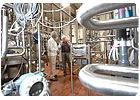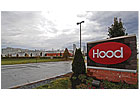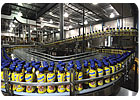
From this location in the historic Shenandoah Valley, just 90 minutes from our nation’s capital, the New England-based processor serves its southernmost markets east of the Rocky Mountains (plus Wal-Mart stores nationwide), strategically located near key transportation arteries as well as sufficient raw-milk supplies as the company expands its marketing reach.
Built in 2000 and expanded over the next four years, the Winchester plant packages aseptic and extended-shelf-life dairy and non-dairy products, including Lactaid lactose-free milk, Nesquik flavored milk beverages, Coffee-Mate creamers and some Hood-branded products. In all, the plant processes up to 100 million gallons annually, operating 24 hours a day, seven days a week.
And as Hood expands its presence in the West - most recently with the acquisition of California’s Crystal Cream & Butter, a longtime Hood co-packing partner - it’s natural to wonder how the company plans to apply the successes of Winchester to its new western plant. The Crystal plant, in the Golden State’s capitol of Sacramento, is a DSD operation primarily of HTST products with some ESL operations; having divested the HTST business, Hood intends to retrofit the plant for more ESL output, primarily in paper packaging.
“It’ll be more to balance out what’s done on both coasts,” says Scott Blake, Hood’s senior vice president of operations. The new facility further will allow Hood to bring more of its co-packed product in house for the western market.
“We’ll integrate some of that in that facility,” Blake says, adding that it also will allow the company to add capacity for paper-packaged products in 2008. “It will also give us more flexibility on the types of products we run.”
Blake notes it’s too early in the game to say just how much the former Crystal plant will eventually resemble Winchester. But a visit to the Virginia facility reveals just how Hood is able to dominate the ESL market by using some of the latest high-speed fillers and related technology.

Liquid assets
Winchester’s cavernous four-bay receiving area takes in 20 to 40 tankers per day, depending on the current product mix, explains operations manager Marc Humphreys. Most of the conventional raw milk comes from the Mid-Atlantic region and Pennsylvania, while organic milk is trucked in from New England and the Midwest.An additional receiving bay handles ingredients like sucrose, fructose and corn syrup, serviced by a staging area for sugar tankers and cream loadouts. Humphreys explains that Winchester’s excess cream is hauled to Hood’s plant in Oneida, N.Y., to make whipping cream and other higher-fat products.
Raw milk is offloaded into an array of storage tanks, including an 8,000-gallon silo for ultrafiltered skim that’s used to make Hood Calorie Countdown, a low-calorie and low-carbohydrate dairy beverage. There are also six set tanks for Lactaid lactose-free milk.
“The majority of our storage is after receiving,” Humphreys says. “Milk doesn’t sit around long.”
All milk is warm-separated into cream and skim. “Then we batch from there, and it all goes through an HTST system,” Humphreys explains. “Even thought it goes through HTST, we still consider it raw product until it goes through the VTIS [vacuum thermal instant sterilization, for aseptic and ESL products].”

Works great, more filling
The rapidly beating heart of the Winchester operation is the Shibuya aseptic filler, installed in late 2005, which can fill up to 600 bottles a minute, according to Jim Sylvester, senior director of operations. During a recent visit, Nesquik chocolate milk was coming off this high-speed line, going from empty HDPE bottle to sealed and shrink-sleeved finished product in just a blink or two of an eye.In the Shibuya’s spacious control room, a computer spits out a sheet every 30 minutes with data showing whether or not the filler is meeting specific operating parameters. Data printed in green means the filler is performing up to spec, Sylvester explains; otherwise, adjustments are made as needed.
“It’s a night-and-day difference between aseptic and ESL” because of the types of technology involved, Sylvester remarks. “We need very skilled people to detect any problems, and we’re very fortunate to have them.”
On the ESL side, Coffee-Mate Pumpkin Spice non-dairy creamer is coming off the Serac filler, enclosed in its own room and run by an operator in a jumpsuit and mask to ensure a sterile environment. Viewed through the windows, this filler closely resembles a standard rotary filler. Humphreys explains that it has three sections: treatment, where bottles are sterilized with a hydrogen peroxide solution; rinsing, where bottles are flushed with sterile water; and filling, where bottles receive their contents and are capped off with a foil seal.
The Serac filler’s voracious appetite for PET bottles is sated by a Sidel blow-molding machine, which can make up to 34,000 bottles an hour. Until this equipment was installed in 2004, no other blow-molding machine available at the time could keep up with the filler, Humphreys says. “It’s really helped our efficiency,” he says. “This runs faster than the filling machines, so when they fill the line, it shuts off.”
Bottle preforms are dumped into a hopper that loads them into the machine. Preforms are loaded onto a spindle and run into an oven to heat them. Then they’re transferred to the blow mold, which spins them into full-size bottles before ejecting them to the line.
Finished product is palletized and wrapped, and each pallet gets a “license plate” - a label that’s coded for whether it goes to the “paper” or “plastic” side of warehouse, Humphreys explains. The cold-storage warehouse has more than 19,000 pallet spaces, of which about a quarter is for paper-packaged products. The paper side is manually forklifted, while the plastic side is equipped with an automated storage and retrieval system. This computer-controlled system pulls pallets based on priority for load-out.
As high-tech as the aseptic and ESL lines are, Humphreys says that Winchester’s “bread and butter” are the paper lines. At their core are three Evergreen form-fill-seal machines that can fill up to 300 cartons a minute. Products like Lactaid in gable-top half-gallon cartons with fitments come off these lines. Another line fills Lactaid in 96-ounce HDPE bottles.
“This plant produces so much so fast, if a line goes down, it’s like dominoes -everything’s got to fall into place,” Humphreys says. “We really have a lot of good people. They really keep it running and do a great job.”
Keeping it running
Until just recently, one of the biggest challenges at Winchester was keeping up with demand. “From the day this facility was built until a year and a half ago, the need for more capacity was growing,” Blake says.The addition of new equipment and technology has allowed the plant to catch up with demand. However, expectations continue to evolve, as Blake notes that the Winchester plant was built primarily for products in plastic packaging. “We see multiserve paper as very important. It’s a growing category for us,” he says, noting that cost and consumer preference are among the factors. “On the single-serve side, plastic will continue to grow. But on the multiserve side, paper continues to be a predominant player for us.”
The Hood operations team is confident in its work force’s ability to take on future demands. “When it was started up with all new people, the challenge was training everybody to get it running efficiently,” Blake says. “Today, it’s one of the most efficient facilities in the industry.”
In 2000, operations began with 78 people and four fillers that packaged 60 million gallons a year. Today, the ranks number 400 with a capacity in excess of 100 million gallons.
With that growth, training is key to maintain a skilled team of operators immersed in a culture of safety and efficiency. “We’re constantly doing training with all our employees,” Blake notes, with refreshers held as needed between scheduled sessions. Sylvester adds: “Everyone has to do yearly computer training and there are tests along with that. That’s gone a long way to help.”
Daily management meetings with each shift review progress and address production issues. “If there’s a problem, it’s reviewed and corrective action is taken,” Blake says.
Food safety issues are addressed by an in-house quality team, augmented by third-party audits done at the plant and commissioned by Hood of its suppliers’ facilities. “Food safety is a large part of our overall program,” Blake stresses.
Dr. Peggy Poole, Hood’s vice president of R&D and quality control, notes the company has a quality management system in place that includes food safety initiatives such as ingredient testing; lot trace and recall; in-process quality control; supplier testing and requirements; HACCP; allergen controls; transportation guidelines; split sample programs; and bio-security guidelines.
Further, employees are encouraged to come forward with their concerns or suggestions to improve operations. “They’re very comfortable communicating with all the managers. We have an open-door policy,” Sylvester says. “They are very demanding people as far as safety and their work environment. They keep everything in check. They demand a lot - in a good way.”
Blake adds: “They take accountability very seriously. We take input on every change we make. They’re part of how successful this facility is. They understand what we need to do to make improvements.”
Conversely, Hood management strives to maintain an open line of communication back to its team members. “Communication with our employees is essential,” Blake says. “They need to know how we’re doing not just as a facility, but as a company.”
AT a glance
HP HoodLocation: Winchester, Va.
Year opened: 2000; expanded 2004.
Size: 441,532 square feet
Number of employees: 400 on 12-hour shifts.
Products made: ESL and aseptic milk (conventional and organic), flavored milk, non-dairy creamer, dairy and non-dairy beverages, including Lactaid, Nesquik and Coffee-Mate.
Total processing capacity: 100 million gallons annually.
Pasteurization: Two HTST systems totaling 20,000 gallons per hour; six VTIS, totaling 35,000 gallons per hour.
Filling lines: Three ESL plastic, one aseptic/ESL, three half-gallon gable-top.
Storage capacity: Four 60,000-gallon raw tanks, five 8,000-gallon cream tanks, two 40,000-gallon skim tanks, one 8,000-gallon retentate/skim tanks, six Lactaid set tanks with 340,000-gallon capacity.
extras
The following companies are among HP Hood’s key supplier partners:Alcoa, www.alcoa.com
Alfa Laval, www.alfalaval.com
APV, www.apv.com
Arpac, www.arpac.com
Bostik, www.bostik.com
Douglas Machine, www.douglas-machine.com
Ecolab, www.ecolab.com
Evergreen Packaging Equipment, www.evergreenpackaging.com
Feldmeier, www.feldmeier.com
FMC Biopolymer, www.fmcbiopolymer.com
Mettler-Toledo, us.mt.com
Nordson, www.nordson.com
Pall, www.pall.com
Serac, www.serac-group.com
Shibuya, www.shibuya-int.com
Sidel, www.sidel.com
Tetra Pak, www.tetrapak.com

